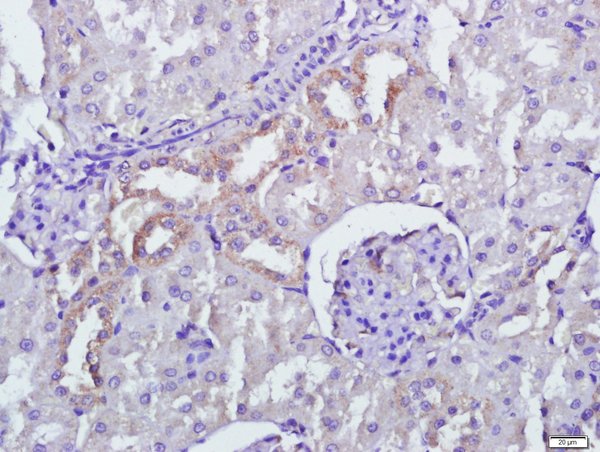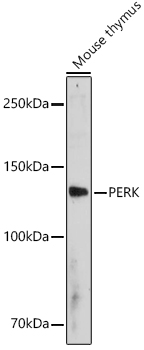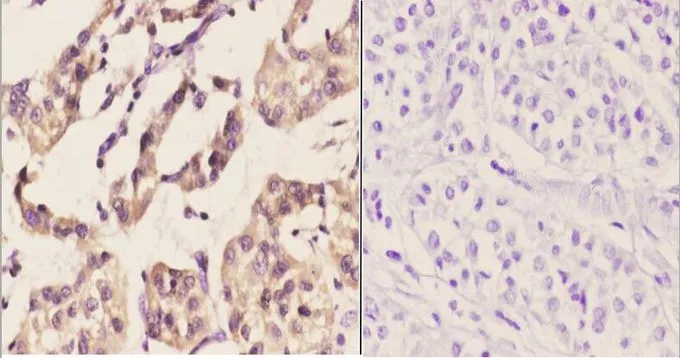PERK antibody
GTX129275
ApplicationsWestern Blot, ImmunoHistoChemistry, ImmunoHistoChemistry Paraffin
Product group Antibodies
TargetEIF2AK3
Overview
- SupplierGeneTex
- Product NamePERK antibody
- Delivery Days Customer9
- Application Supplier NoteWB: 1:500-1:3000. *Optimal dilutions/concentrations should be determined by the researcher.Not tested in other applications.
- ApplicationsWestern Blot, ImmunoHistoChemistry, ImmunoHistoChemistry Paraffin
- CertificationResearch Use Only
- ClonalityPolyclonal
- Concentration0.69 mg/ml
- ConjugateUnconjugated
- Gene ID9451
- Target nameEIF2AK3
- Target descriptioneukaryotic translation initiation factor 2 alpha kinase 3
- Target synonymsPEK, PERK, WRS, eukaryotic translation initiation factor 2-alpha kinase 3, PKR-like ER kinase, PRKR-like endoplasmic reticulum kinase, pancreatic EIF2-alpha kinase, pancreatic eIF-2alpha kinase, protein tyrosine kinase EIF2AK3
- HostRabbit
- IsotypeIgG
- Protein IDQ9NZJ5
- Protein NameEukaryotic translation initiation factor 2-alpha kinase 3
- Scientific DescriptionThe protein encoded by this gene phosphorylates the alpha subunit of eukaryotic translation-initiation factor 2, leading to its inactivation, and thus to a rapid reduction of translational initiation and repression of global protein synthesis. This protein is thought to modulate mitochondrial function. It is a type I membrane protein located in the endoplasmic reticulum (ER), where it is induced by ER stress caused by malfolded proteins. Mutations in this gene are associated with Wolcott-Rallison syndrome. [provided by RefSeq, Sep 2015]
- Storage Instruction-20°C or -80°C,2°C to 8°C
- UNSPSC12352203
References
- Piper JA, Al Hammouri N, Jansen MI, et al. L-Proline Prevents Endoplasmic Reticulum Stress in Microglial Cells Exposed to L-azetidine-2-carboxylic Acid. Molecules. 2023,28(12). doi: 10.3390/molecules28124808Read this paper
- Xiaofeng G, You W, Qi J, et al. PERK-STING-RIPK3 pathway facilitates cognitive impairment by inducing neuronal necroptosis in sepsis-associated encephalopathy. CNS Neurosci Ther. 2023,29(4):1178-1191. doi: 10.1111/cns.14095Read this paper
- Huang CY, Deng JS, Huang WC, et al. Attenuation of Lipopolysaccharide-Induced Acute Lung Injury by Hispolon in Mice, Through Regulating the TLR4/PI3K/Akt/mTOR and Keap1/Nrf2/HO-1 Pathways, and Suppressing Oxidative Stress-Mediated ER Stress-Induced Apoptosis and Autophagy. Nutrients. 2020,12(6). doi: 10.3390/nu12061742Read this paper







![WB analysis of HEK293 (1) and PERK(AA: 929-1116)-hIgGFc transfected HEK293 (2) cell lysate using GTX82759 PERK antibody [5G5].](https://www.genetex.com/upload/website/prouct_img/normal/GTX82759/GTX82759_20170912_WB_w_23061322_763.webp)